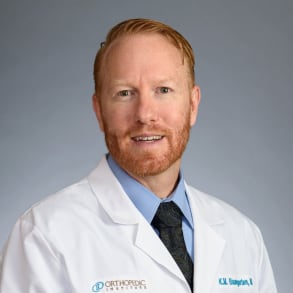This non-sport related study aimed to examine the patient’s return to activity post TSA or RTSA procedures. Utilizing the Shoulder Activity Level outcomes tool designed by Brophy, et. al. and additional secondary outcomes tools, the authors hypothesized both TSA and RTSA would result in improved patient activity levels.
Wright Medical Clinical Summary
To view online :
Keith M. Baumgarten, MD, Peter S. Chang, MD, Tasha M. Dannenbring, PhD, Elaine K. Foley, BS
SKU: AP-013586
E. I'm Keith Baumgarten. I live in Sioux Falls, South Dakota. I've been an orthopedic surgeon specializing in sports medicine and shoulder surgery there for the last 14 years. 2018 I published an article in the Journal of Shoulder and Elbow Surgery looking at patient activity level after total shoulder Arthur Plast e. So we all know that after total shoulder Arthur plastic patients, pain improves. Strength improves, range motions improves. Prior to the study, there was little data available to guide us to counsel our patients to help let them know if their activity levels could improve as well. So the hypothesis of this study was that total shoulder Arthur plastic both an atomic and reverse total shoulder Arthur placidity would improve patients activity levels. The score that we used was the Shoulder Activity Levels score that was published in 2005 by Brophy and Marks. So we enrolled 80 patients with an atomic total shoulder, Arthur Plastics and 40 patients with reverse total shoulder Arthur Plast ease and had a mean follow up of 3.7 years on. What we looked at was quality of life scores, including the same score the western Ontario osteoarthritis score, the American shoulder elbow score and the simple shoulder tests, which evaluates patients quality of life. In addition, we asked them to answer the shoulder activity level. This is a score that had a range from 0 to 20 that measured the activities patients could do both before and after surgery. With the findings of the study, we found that all quality of life scores significantly improved, UH, upto API level of 0.1 That means that there's a significant statistical difference between the patients perceived quality of life before and after surgery. When we looked at the total shoulder, Arthur Plasticky uh, the patient's response to total shoulder Arthur plastic with the activity level, we saw that on a scale from 0 to 20 the mean score was six and the postoperative score was eight, and that was a finding a P value of 80.6 So there were statistically significant improvements among the cohort of patients having both an atomic and total shoulder Arthur classes that they did have improvements in their activity level. Other findings that we found was that the amounts and direction of change of the shoulder activity level directly correlated to the patient's preoperative scores. So if a patient was doing very poorly with their activity level, they had a greater chance of improvement. Comparative patient who had superior activity level Those patients tend to have a little bit of deterioration of their scores after surgery. So the main findings of our study was that, yes, an atomic converse Total shoulder Arthur Plasticky do increase patients activity levels after surgery, along with decrease pain, improved range of motion and prove strength. We did see that the preoperative scores were correlated with the postoperative scores. In addition, the last findings of our study that did show that patients did not have to decrease their activity level to maintain great outcomes with the quality of life scores.


